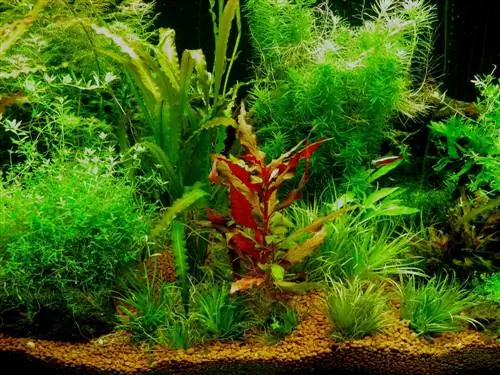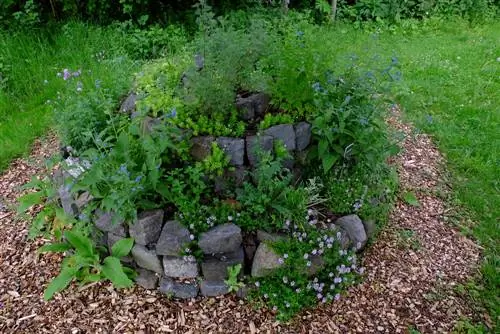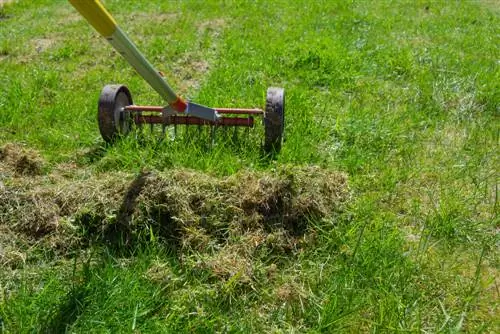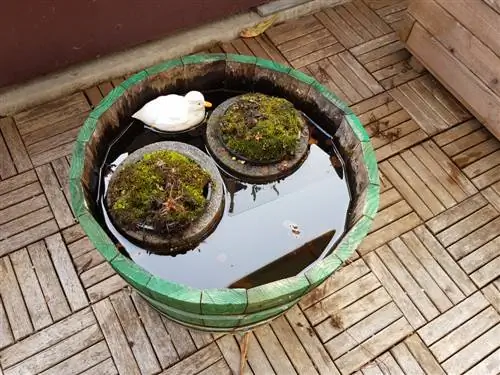- Author admin [email protected].
- Public 2023-12-16 16:46.
- Last modified 2025-06-01 06:02.
Read the commented source moss profile here for useful information about growth, varieties and use. Compact tips explain how to properly plant and care for Fontinalis antipyretica.

What is spring moss and how is it used?
Spring moss (Fontinalis antipyretica) is an evergreen aquatic plant that serves as a bio-indicator of water quality and is used in ponds and aquariums as an oxygen producer and hiding place for aquatic life. It prefers clean, slow-flowing waters and grows in water depths of 20 to 300 cm.
Profile
- Scientific name: Fontinalis antipyretica
- Varieties: Fontinalis a. var. gracilis, Fontinalis a. var. gigantea
- Genus: Spring mosses (Fontinalis)
- Family: Fontinalaceae
- Growth type: aquatic plant
- Growth habit: creeping, flooding
- Growth length: 5 cm to 40 cm
- Leaf: lanceolate
- Leaf characteristics: wintergreen, evergreen
- Flowering: omitted
- Winter hardiness: hardy
- Use: Garden pond, aquarium
Growth
Spring moss (Fontinalis antipyretica) is an evergreen aquatic moss that is widespread in the Northern Hemisphere. The plant species is one of the deciduous mosses (Bryophyta). With more than 15,000 species, deciduous mosses form the largest family of moss species. In contrast to most of its relatives, spring moss does not thrive on land under trees, in beds or on the tops of walls, but in slow-flowing water. The plant combines its special way of life with decorative growth, characterized by these characteristics:
- Growth type: evergreen underwater plant.
- Growth habit: flowing, densely leafed, soft stems.
- Growth length: 5 cm to 40 cm.
- Roots: rootless anchoring to the substrate using adhesive organs.
- Occurrence: in clean, flowing waters up to depths of 18 meters.
- Interesting properties for hobby gardeners and aquarists: easy to care for, tolerates cutting, hardy, densely bushy, shade tolerant, does not grow overgrown.
Video: Spring moss in the aquarium
Leaf
It is thanks to these decorative leaves that spring moss is classified as a deciduous mosses:
- Leaf shape: lanceolate, pointed, folded once.
- Sheet size: 5 mm to 8 mm long.
- Leaf color: dark green, wintergreen or evergreen.
- Arrangement: three-line (in three longitudinal rows along the stems).
Varieties
Common spring moss is a diverse aquatic plant. The pure species Fontinalis antipyretica likes to form adapted varieties under modified conditions. The following table introduces you to two well-known spring moss subspecies:
| Types and varieties | Fontinalis antipyretica | Fontinalis antipyretica var. gracilis | Fontinalis antipyretica var. gigantea |
|---|---|---|---|
| Synonym | Common spring moss | Small spring moss | Giant spring moss |
| Status | Art | Variety | Variety |
| identifying feature | dark green, flooding or perched | Stem base rigid, naked | golden brown, wider, splayed leaves |
| Occurrences | in slow-moving waters | in fast-flowing mountain streams | in still water |
| Good for | Garden pond | Stream | Aquarium |
Good to know: Compared to the finicky common spring moss, giant spring moss is almost undemanding when it comes to water quality.
Usage
Spring moss is one of the most valuable underwater plants for the pond and aquarium with these convincing uses:
- Informative indicator plant for good water quality.
- Serves as a hiding place and spawning place for fish and other aquatic creatures.
- Natural oxygen producer, even in winter garden ponds under ice.
- Decorative all year round with evergreen, densely bushy trunks.
- Concealed technical devices with tied shoots in the pond and aquarium.
Fontinalis antipyretica is not suitable for direct algae control. After all, spring moss torpedoes harmful algae growth by removing nutrients from the water.
Planting spring moss
The best time to plant all aquatic plants is in spring. From April to September you can buy spring moss from specialist aquatic plant shops. Prices range between 3.95 euros and 6.90 euros. The right location depends on a balanced combination of light, temperature, water depth and water quality. Planting is incredibly easy. How to plant spring moss correctly:
Location
These are the best conditions for spring moss:
- Ideally a sunny to semi-shady location.
- Optional in a shady location with slight losses in growth.
- Water depth: 20 cm to 300 cm.
- Water quality garden pond: clean, low in nutrients, 5° to 25° Celsius, light to moderate current.
- Water quality aquarium: 4° to 26° Celsius, pH value 5.0 to 7.0, carbonate hardness 0 - 15°dKH.
Planting Tips
As an underwater plant, spring moss is simply poured from the pot into the water. The stems sink to the bottom of the ground. There the water moss holds itself firmly to the substrate or surfaces with its adhesive organs. Spring moss can be easily attached to stones, roots and technical devices. This is best achieved with a water-compatible plant glue, such as NatureHolic (€9.00 on Amazon).
Excursus
Moss of the year
In 2006, the Bryological-lichenological Working Group for Central Europe (BLAM) named spring moss the moss of the year. With this choice, the committee wants to point out the particular suitability of submerged leaf mosses as meaningful bio-indicators of water quality. As underwater plants, spring mosses absorb dissolved nutrients across their entire surface. Due to its low tolerance to pollutants, Fontinalis antipyretica reacts particularly sensitively to any environmental influences.
Care for spring moss
In the right location, spring moss is easy to care for and undemanding. Read the best care tips for ponds and aquariums here:
- Fertilizing: From April to September with a special liquid fertilizer for aquatic plants according to the manufacturer's instructions.
- Cutting: cut back excessively long stems if necessary.
- Propagate: in early summer, either divide spring moss cushions or cut off long shoots as cuttings.
Popular varieties
No varieties are known beyond the common spring moss and its varieties.
FAQ
Does spring moss form roots?
Spring moss is one of the species of deciduous moss that lives under water. These aquatic plants are characterized by growth without roots. With special adhesive organs, the water moss plants stones, rocks and the ground in flowing and stagnant waters.
Can spring moss overwinter in a garden pond?
Common spring moss (Fontinalis antipyretica) is a native deciduous moss and completely hardy. In the wild, the water moss inhabits flowing waters down to depths of 18 meters. In the garden pond, the aquatic plant thrives all year round and is evergreen, even under a winter ice cover.
How do giant spring moss and common spring moss differ?
Giant spring moss (Fontinalis antipyretica var. gigantea) is a strong, large, natural variety of the original species common spring moss (Fontinalis antipyretica). The unusually large water moss impresses with its densely leafy, lushly branched growth. Individual stems can be up to 10 millimeters wide. In contrast to the common spring moss, giant spring moss prefers calm, stagnant water and also tolerates poorer water quality. As an underwater plant in the aquarium, aquatic moss takes on a golden-green color under strong lighting.
Should you plant Java moss or spring moss in the aquarium?
Java moss (Taxiphyllum barbieri) and spring moss (Fontinalis antipyretica) can hardly be distinguished in terms of growth and use. Both aquatic mosses are deciduous mosses. The plants thrive with flowing stems on which there are evergreen leaves and adhesive organs. Java moss and spring moss are very suitable for concealing annoying devices. Furthermore, both underwater plants are useful as natural bio-filters that remove nutrients from the water. Against this background, it is your individual decision as to which water moss you prefer in the aquarium.
Which aquatic plants can you combine spring moss in the pond?
In the garden pond, spring moss harmonizes well with floating and underwater plants. These include hornwort (Ceratophyllum demersum), dense-leaved waterweed (Egeria densa) and milfoil (Myriophyllum aquaticum) below the water surface. Spring moss maintains good neighbors with these floating plants: water hyacinth (Eichhornia crassipes), frogbit (Hydrocharis morsus-ranae), star liverwort (Riccia fluitans) and swimming fern (Salvia natans).






